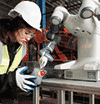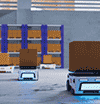Robotic technology in the workplace
Highlights from an NSC white paper

“Robotics have long been deployed by organizations to improve operational efficiencies, but as companies increasingly look toward a more automated future, the many benefits this technology brings to workplace safety programs cannot be overlooked.”
That’s how Katherine Mendoza, senior director of workplace programs at the National Safety Council, announced the release of a white paper from the nonprofit’s Work to Zero initiative.
Published in May, “Improving Workplace Safety with Robotics” looks at how robots can help reduce injuries and fatalities, as well as risks and other considerations. Here are the report’s key points.
Robots are being used for:
- Industrial facility inspection and gauge-reading
- Confined space inspections
- Parts, goods and material transportation
- Machine tending, parts repositioning and pick-and-place work
- Hazardous environment materials handling
- Precision cutting and welding
They’re available in 3 broad categories …

Remote-controlled robots (operated by a human in real time)

Pre-programmed robots (designed to perform a series of movements)

Autonomous robots (pre-programmed but with sensors or cameras that allow for real-time adjustments)
… and in 5 common configurations:
- Autonomous mobile robots can perform real-time mapping and navigate industrial environments without direct oversight of an operator or being limited to a fixed, predetermined path. With proximity sensors, camera-based computer vision and artificial intelligence-powered control systems, they can find and pick up objects, perform visual inspections, move goods and equipment, and reroute around obstacles.
- Automated guided vehicles rely on magnetic strips placed onto the floor of an industrial facility. They can perform visual inspections and carry goods and equipment, but without the ability to steer around obstacles or find and pick up objects.
- Articulated robots feature arms and grippers or other types of effectors to manipulate physical objects. They may be fixed to a particular location within a facility or mounted to another vehicle. They’re often used for tasks involving welding, pick and place, and packaging.
- Humanoid robots mimic the appearance and some of the capabilities of humans. They don’t currently have major uses within industrial safety.
- Cobots are designed to work alongside humans, performing repetitive manual tasks and moving parts from one machine to another so workers can continue with more complex and varied jobs. Proximity and strain sensors limit the risk of injury to people working around them and reduce or eliminate the need for cages, screens and light curtains to prevent human-machine collisions.
They offer 5 major safety and health benefits:
- Reduce the risk of falls from height. The use of remote-controlled robots that can scale walls decreases or eliminates the need for workers to perform certain tasks.
- Decrease the risk of musculoskeletal disorders. Because robots are often designed for repetitive tasks and can lift heavier loads than humans, their use could help reduce MSDs.
- Minimize exposures to hazardous environments and/or substances. Autonomous or remote-controlled robots can work in hot, toxic or low-oxygen environments, sparing workers from potentially dangerous exposures.
- Reduce the number of injuries caused by fatigue. Worker fatigue can be exacerbated by repetitive, hard manual labor. Robots can take over that repetitive work.
- Improve worker satisfaction. Fewer injuries and fatalities can bolster worker morale. Technologies also can give workers more time for stimulating work – increasing job satisfaction.
They present some risks and other things to think about:
The potentially high cost of not only purchasing a technological solution but also deploying, adjusting and/or reprogramming it may put it out of reach for some employers.
Robotics also may disrupt current work operations, and certain technologies may have limited abilities because of the work environment. For example, ultra-wideband radio proximity detection can have difficulty tracking humans in highly metallic environments.
Additionally, dynamic work environments may be too complex for current robotic technologies. They include various obstacles, rough terrain, dirt, extreme weather or moving vehicles/workers.
Finally, employers who incorporate robotic technology will need to address concerns that robots will eventually replace workers. Although some jobs may become automated, reduced business costs can lead to increased investments and the creation of new jobs in other areas.
In conclusion:
The potentially high cost of not only purchasing a technological solution but also deploying, adjusting and/or reprogramming it may put it out of reach for some employers.
Robotics also may disrupt current work operations, and certain technologies may have limited abilities because of the work environment. For example, ultra-wideband radio proximity detection can have difficulty tracking humans in highly metallic environments.
Additionally, dynamic work environments may be too complex for current robotic technologies. They include various obstacles, rough terrain, dirt, extreme weather or moving vehicles/workers.
Finally, employers who incorporate robotic technology will need to address concerns that robots will eventually replace workers. Although some jobs may become automated, reduced business costs can lead to increased investments and the creation of new jobs in other areas.
Want more? Download the white paper and other Work to Zero papers at nsc.org
About the white paper
The “Improving Workplace Safety with Robotics” white paper is based on information and data gathered from reviews of industry and academic publications; reporting from research and advisory firm Verdantix; interviews with technology vendors; and three real-world case studies from General Electric, automotive parts manufacturer thyssenkrupp Bilstein and Canadian utility National Grid.
NSC’s Work to Zero Initiative

The Work to Zero Initiative, launched in 2019 with financial support from the McElhattan Foundation, wants to eliminate workplace fatalities by 2050. “Using decades of insight and data, and leveraging the expertise of its membership and network, Work to Zero will identify promising technology innovations geared toward eliminating workplace fatalities within our lifetime.”
Post a comment to this article
Safety+Health welcomes comments that promote respectful dialogue. Please stay on topic. Comments that contain personal attacks, profanity or abusive language – or those aggressively promoting products or services – will be removed. We reserve the right to determine which comments violate our comment policy. (Anonymous comments are welcome; merely skip the “name” field in the comment box. An email address is required but will not be included with your comment.)

